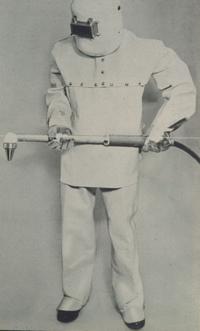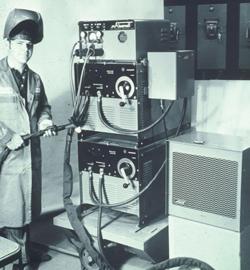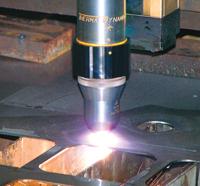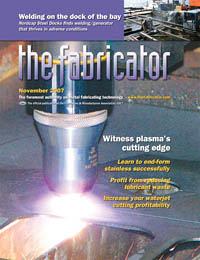Chief Science Engineer
- FMA
- The Fabricator
- FABTECH
- Canadian Metalworking
Categories
- Additive Manufacturing
- Aluminum Welding
- Arc Welding
- Assembly and Joining
- Automation and Robotics
- Bending and Forming
- Consumables
- Cutting and Weld Prep
- Electric Vehicles
- En Español
- Finishing
- Hydroforming
- Laser Cutting
- Laser Welding
- Machining
- Manufacturing Software
- Materials Handling
- Metals/Materials
- Oxyfuel Cutting
- Plasma Cutting
- Power Tools
- Punching and Other Holemaking
- Roll Forming
- Safety
- Sawing
- Shearing
- Shop Management
- Testing and Measuring
- Tube and Pipe Fabrication
- Tube and Pipe Production
- Waterjet Cutting
Industry Directory
Webcasts
Podcasts
FAB 40
Advertise
Subscribe
Account Login
Search
The life and times of plasma cutting
How the technology got where it is today
- By Nakhleh Hussary, Ph.D. and Thierry Renault
- November 6, 2007
- Article
- Plasma Cutting
Metal cutting has existed as long as the welding process itself. One popular early method involved using a welding-type torch with a wire continuously feeding at 300 to 650 inches per minute (IPM). The wire was surrounded by a high flow of shield gas composed of argon, helium, nitrogen, oxygen, carbon dioxide, air, or a combination of those gases, at currents ranging from 300 to 800 amps. This technique cut 1-inch-thick stainless steel plates at 15 IPM and 1-in.-thick aluminum at 20 IPM.
However, the plasma cutting process as we know it today did not exist until Dr. R. M. Gage's invention at Union Carbide's research labs in 1955. As described in Gage's patent, the constriction of a welding arc by wall stabilization leads to increased arc energy density and momentum.
One end of the arc is attached to the negative electrode inside the torch (cathode), and the other end is attached to the metal to be cut (anode). This configuration often is referred to as transferred arc.
The First 15 Years
The challenges that faced plasma cutting at its inception are the same it faces in today's metal fabricating environment. Improvements still are aimed at increasing cutting speed, better cutting quality, and consumable life.
To the credit of the early researchers and engineers, a significant number of innovations occurred in the first 15 years of the life of this process. These innovations included increasing the arc energy density and stability, varying plasma composition, improving component cooling, controlling fluid dynamics, and using exotic materials.
The early plasma cutting torch comprised a tungsten rod electrode surrounded by the constricting nozzle. At that time the shield gas was an inert gas that shielded the tungsten electrode from the reactive atmosphere to increase its life. To help constrict and stabilize the arc and further cool the torch, water was injected coaxially downstream of the electrode. Later the water was swirled to improve arc stabilization, and it became known as the liquid turbine.
Plasma cutting proved to be an effective process for cutting nonferrous metals, but it would be able to compete with oxyfuel cutting on mild steel only if it took advantage of the reaction between iron and oxygen. Its limitation was the very short electrode life, since tungsten readily reacts with oxygen.
Service life was improved by introducing the oxidizing gas in the nozzle, below the tungsten electrode, while maintaining the shielding gas around the electrode. Swirling the main plasma gas further stabilized the arc.
Unfortunately, the cut quality still was not comparable to oxyfuel's. Injection of a second fluid (air, oxygen, water) around the arc jet downstream of the nozzle exit marked a significant process improvement. It is known as dual flow cutting, and today the second fluid is referred to as the shield or secondary gas. This auxiliary flow protects the torch front end from slag, molten droplets, and even metal vapor, preventing a metallic conducting bridge between the torch and the workpiece.
This invention improved quality by reducing the top edge rounding of the cut. Moreover, the secondary gas drove the arc deeper into the cut, minimized the adherence of dross at the bottom of the cut (especially with water), and doubled cutting speeds.

This water-cooled hand torch, which could handle up to 1,000 amps, was cutting-edge technology in the early 1960s. Because little was known about how plasma could affect the human body, fabricators wore protective suits as an extreme measure.
The cutting currents were raised continually (300 amps and higher) to increase cutting speeds. Such high currents, however, significantly increased the wear rate of the emissive element (thoriated tungsten), affecting efficiency and productivity.
A breakthrough came with the invention of the button-type electrode. The electrode, when embedded into a water-cooled copper holder, enhanced emissive element cooling. Moreover, thoriated tungsten was replaced by zirconium when the plasma forming gas was air. The electrode life increased from a few minutes with tungsten to a few hours with zirconium, and air cutting of mild steel became popular.
However, it was practically impossible to use zirconium cathode at arc currents higher than 300 amps. At the end of the 1960s, the use of hafnium in the former Soviet Union to replace zirconium, lanthanum, and strontium further improved electrode life in air plasma cutting.
The early years of development were very fruitful. The basics of the process were well understood. The low-voltage start technique was invented in 1957, even though it wasn't widely used until the mid-1980s, and the electromagnetic noise emitted during arc ignition was eliminated. These innovations would become perfected in the three decades to follow.
The Spring of Automation
Process improvements continued throughout the 1970s and '80s. However, plasma cutting really took off when it became automated. It started with the implementation of NC, CNC, and DNC and the development of height controllers and workpiece-sensing systems, all of which are critical in maintaining high cut quality. Advanced gas consoles ensured the proper delivery of fluids to the torch to minimize downtime.
The cutting market was driven by cost reduction. At the time the process of choice was water injection, as it gave the best quality, the highest speeds, and the longest consumable life. The process was versatile, cutting low-carbon steel and nonferrous metals with varying current and the same consumables and fluids, and it minimized downtime.
Soon efforts were invested in designs for the arc chamber. Similarly, current ramping and smooth pressure buildup in the arc chamber were shown to improve consumable life and cut quality. These were the first attempts at controlling the process transients. These extreme transitions raise gas temperatures to about 35,000 degrees F (from room temperature) and increase speeds to about 4,500 MPH (from less than 600 MPH) in just tens of milliseconds.
Plasma Cutting Reinvented
The rate of advancements in plasma cutting slowed in the 1980s compared to previous decades. Single-gas (air) portable units for manual cutting became popular in the U.S. with chopper and inverter power supply technologies, while Japan saw the birth of what came to be called high-definition plasma cutting at the end of the decade.
The 1990s marked a turning point in the evolution of plasma cutting. Major breakthroughs were made in the wear rates of hafnium electrodes when used with oxygen plasmas, increasing consumable life, cutting speed, and quality. It was then determined that the arc shutdown is a key stage because of the interaction of the molten hafnium, the plasma arc, and the gas flow.
Plasma cutting became as competitive on mild steel as it was on stainless steel and aluminum. It became a cost-effective alternative to the emerging laser and the traditional oxyfuel.

This 400-amp power source for a water-cooled torch from the early 1970s is much larger than power sources today.
In the last 10 years, the process has taken full advantage of automation with integration of power supplies, gas controllers and CNCs, table technology, and nesting software. Significant R&D has been devoted to consumable life, cut speed, and quality, as well as transients at the start (arc ignition, pilot, and transfer) and at the end of the cut to improve process reliability.
Reaping the Rewards
Today manufacturers are developing automated systems using microprocessors and state-of-the-art control for current, gas delivery, and torch motion. Plasma cutting has become a cost-effective process, with relatively low expenditures for capital and operation. For NC and non-NC plasma and electron-beam machines, exports grew 20 percent, to $1.28 billion between 1995 and 2000, and imports tripled to about $0.4 billion during the same period.1
This success wasn't obvious 20 years ago, when consumable life was short, but heavy investment in R&D to improve consumable life turned things around. Plasma cutting equipment manufacturers continue the effort to improve the process through internal measures (building high-end teams of scientists and engineers) and external developments (collaborations with research institutes and universities). This activity has doubled consumable life in the last 15 years so that it now is one of the main selling points of a plasma cutting system.
Cut quality expectations and terminology have evolved from high quality in the 1960s to square cut in the 1970s to high definition in the 1980s and '90s. These terms all refer to a good-quality cut at high speed with long-life consumables in their respective decades (see Figure 1). More than 50 years of effort have made plasma cutting an economically competitive choice for today's metal fabricators.
Thierry Renault and Nakhleh Hussary are principal arc process engineers with Thermadyne Inc., 82 Benning St., West Lebanon, NH 03784, 603-298-5711, trenault@thermadyne.comand nhussary@thermadyne.com.
Note:
- "The Future of Forming and Fabricating Technology and Processes,"Forming & Fabricating Tech Trends 2003, SME/AFFT —The Association for Manufacturing Technology (AMT) and the Department of Commerce.
About the Authors
Nakhleh Hussary, Ph.D.
Victor Technologies International
16052 Swingley Ridge Road Suite #300
St. Louis, MO 63017
636-728-3000
Thierry Renault
Principal Arc Process Engineer
16052 Swingley Ridge Road Suite 300
St. Louis, MO 63017
636-728-3000
Related Companies
subscribe now

The Fabricator is North America's leading magazine for the metal forming and fabricating industry. The magazine delivers the news, technical articles, and case histories that enable fabricators to do their jobs more efficiently. The Fabricator has served the industry since 1970.
start your free subscription- Stay connected from anywhere

Easily access valuable industry resources now with full access to the digital edition of The Fabricator.

Easily access valuable industry resources now with full access to the digital edition of The Welder.

Easily access valuable industry resources now with full access to the digital edition of The Tube and Pipe Journal.
- Podcasting
- Podcast:
- The Fabricator Podcast
- Published:
- 04/16/2024
- Running Time:
- 63:29
In this episode of The Fabricator Podcast, Caleb Chamberlain, co-founder and CEO of OSH Cut, discusses his company’s...
- Trending Articles
AI, machine learning, and the future of metal fabrication

Employee ownership: The best way to ensure engagement

Steel industry reacts to Nucor’s new weekly published HRC price

Dynamic Metal blossoms with each passing year

Metal fabrication management: A guide for new supervisors

- Industry Events
16th Annual Safety Conference
- April 30 - May 1, 2024
- Elgin,
Pipe and Tube Conference
- May 21 - 22, 2024
- Omaha, NE
World-Class Roll Forming Workshop
- June 5 - 6, 2024
- Louisville, KY
Advanced Laser Application Workshop
- June 25 - 27, 2024
- Novi, MI




























